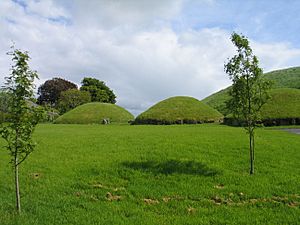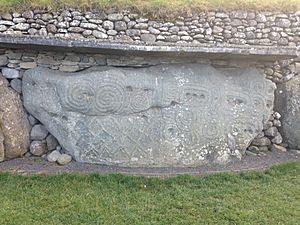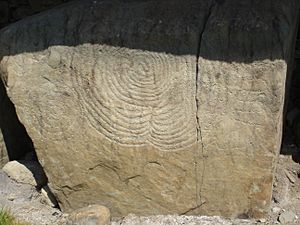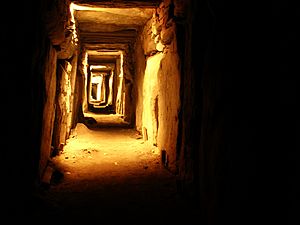Knowth facts for kids

Main mound ("Site 1", right) and smaller mounds at Knowth
|
|
| Location | valley of the River Boyne |
|---|---|
| Region | County Meath, Ireland |
| Coordinates | 53°42′04″N 6°29′30″W / 53.701°N 6.4916°W |
| Type | passage grave |
| Part of | Brú na Bóinne |
| History | |
| Periods | Neolithic |
Knowth is a very old burial site in Ireland. It's a type of tomb called a passage grave from the Neolithic period, which was a long time ago, around 3200 BC. This means it's even older than the pyramids in Egypt! Knowth is part of a special area called Brú na Bóinne, which is a World Heritage Site. It's located in the beautiful valley of the River Boyne in County Meath, Ireland.
Knowth is the biggest passage grave in the Brú na Bóinne area. It has one very large mound, called Site 1, and 17 smaller tombs around it. The main mound is about 12 meters (39 feet) high and 67 meters (220 feet) wide. It covers an area of about one hectare, which is like two football fields!
Inside the main mound, there are two long passages. These passages go in different directions, one to the east and one to the west. They lead to separate burial rooms. The eastern passage opens into a room shaped like a cross. This room has three small areas and special stone basins. People used to place the cremated remains of the dead in these basins. The area on the right is bigger and has more beautiful carvings than the others. This is common in Irish passage graves. The western passage ends in a room that has a stone blocking part of the entrance. This room also had a basin stone, but it was moved later and is now in the passageway.
Contents
Amazing Ancient Art at Knowth
Knowth is famous for its amazing ancient art, called megalithic art. More than 200 decorated stones have been found here! This is more than a third of all the megalithic art found in Western Europe. Many of these carvings are on the large stones that form the edge of the mound, especially near the entrances to the passages.
You can see many different designs in the art. Some common ones are spirals, diamond shapes (called lozenges), and wavy lines that look like snakes. But Knowth also has unique designs, like crescent shapes. What's really interesting is that many of these carvings are on the back of the stones, where they couldn't be seen! This is called "hidden art."
Scientists have different ideas about why this art was hidden. Maybe the people who built Knowth wanted the art to be a secret. Or maybe they just reused old stones and carved on the side that was already decorated. It's a mystery!
Knowth Through Time: A Brief History
Knowth has a long and interesting history. After the great mound was built, people continued to use the site. There's proof of activity during the late Neolithic and Bronze Age. For example, a circle of wooden posts was found near the eastern passage. It seems this area was used for special ceremonies after the main mound was no longer used for burials. Archaeologists found many special gifts, called votive offerings, around these wooden posts.
Over time, the mound at Knowth became damaged, and the entrances to the passages were covered up. For about 2,000 years, the site was mostly unused. However, it was briefly used as a burial ground again, as 35 simple stone graves (called cist graves) were found there.
Later, during the late Iron Age and early Christian period, Knowth became a hill fort. People dug ditches around it and built underground tunnels called souterrains. This was the first time people actually lived at Knowth. It became a very important political center and the capital of a kingdom called Northern Brega.
After the Normans invaded Ireland in the 12th century, they used Knowth as a small castle mound (a motte). Then, the site was given to Cistercian monks from Mellifont Abbey. They used the mound as a farm. They built stone walls and buildings on top of the mound. After the monasteries were closed down, Knowth was mainly used for farming until the Irish state took over most of the site in 1939.
An old Irish text called the Triads of Ireland, written between the 14th and 19th centuries, even mentions the cave at Knowth. The passages at Knowth point east-west, which suggests they might have been built to line up with the sun during the equinoxes (when day and night are equal length). Today, this alignment doesn't happen perfectly. This is because the passages were damaged by later settlers. Also, recent excavations added a concrete wall inside the western entrance, which makes it hard to study the original alignment. It's also possible that the Earth's tilt changes slightly over thousands of years, affecting how ancient monuments line up with the sun.

Uncovering Knowth's Secrets: Archaeology
A small excavation happened at Knowth in 1941. But the really big archaeological work started in 1962. George Eogan from University College Dublin led these major excavations. When he started, people didn't know how big or important the site truly was. The entrances to the western and eastern passages were found in 1967 and 1968. Slowly, archaeologists uncovered all the different layers of history at Knowth. These excavations have led to many books and reports about the amazing discoveries made there. An American-Irish researcher named Martin Brennan did a lot of research on how the passages might have lined up with the sun and stars.
Visiting Knowth Today
If you want to visit Knowth, you can only go on a guided tour. The tours start at the Brú na Bóinne Visitor Centre in Donore. Visitors can look down the eastern passage and explore a modern room that explains more about the site.
See also
 In Spanish: Knowth para niños
In Spanish: Knowth para niños




